Rosuvastatin ameliorates the development of pulmonary arterial hypertension in the transgenic (mRen2)27 rat
- PMID: 19633211
- PMCID: PMC2755976
- DOI: 10.1152/ajpheart.00048.2009
Rosuvastatin ameliorates the development of pulmonary arterial hypertension in the transgenic (mRen2)27 rat
Abstract
We have recently reported that transgenic (mRen2)27 rats (Ren2 rats) exhibit pulmonary arterial hypertension (PAH), which is, in part, mediated by oxidative stress. Since 3-hydroxy-3-methylglutaryl-CoA reductase inhibitors (statins) exhibit beneficial vascular effects independent of cholesterol synthesis, we hypothesized that rosuvastatin (RSV) treatment ameliorates PAH and pulmonary vascular remodeling in Ren2 rats, in part, by reducing oxidative stress. Six-week-old male Ren2 and Sprague-Dawley rats received RSV (10 mg x kg(-1) x day(-)1 ip) or vehicle for 3 wk. After treatment, right ventricular systolic pressure (RVSP) and mean arterial pressure (MAP) were measured. To evaluate treatment effects on pulmonary arteriole remodeling, morphometric analyses were performed to quantitate medial thickening and cell proliferation, whereas whole lung samples were used to quantitate the levels of 3-nitrotyrosine, superoxide, stable nitric oxide (NO) metabolites [nitrates and nitrites (NO(x))], and expression of NO synthase isoforms. In the Ren2 rat, RVSP is normal at 5 wk of age, PAH develops between 5 and 7 wk of age, and the elevated pressure is maintained with little variation through 13 wk. At 8 wk of age, left ventricular function and blood gases were normal in the Ren2 rat. Ren2 rats exhibited elevations in medial hypertrophy due to smooth muscle cell proliferation, 3-nitrotyrosine, NO(x), NADPH oxidase activity, and endothelial NO synthase expression compared with Sprague-Dawley rats. RSV significantly blunted the increase in RVSP but did not reduce MAP in the Ren2 rat; additionally, RSV significantly attenuated the elevated parameters examined in the Ren2 rat. These data suggest that statins may be a clinically viable adjunct treatment of PAH through reducing peroxynitrite formation.
Figures

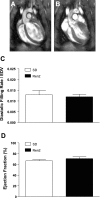
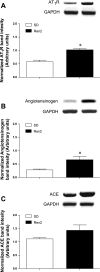


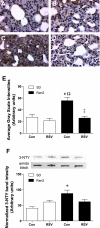
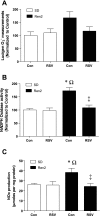
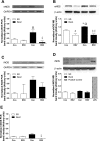
Similar articles
-
Rosuvastatin, a 3-hydroxy-3-methylglutaryl coenzyme a reductase inhibitor, decreases cardiac oxidative stress and remodeling in Ren2 transgenic rats.Endocrinology. 2007 May;148(5):2181-8. doi: 10.1210/en.2006-1355. Epub 2007 Feb 22. Endocrinology. 2007. PMID: 17317778
-
Oxidative stress contributes to pulmonary hypertension in the transgenic (mRen2)27 rat.Am J Physiol Heart Circ Physiol. 2008 Jun;294(6):H2659-68. doi: 10.1152/ajpheart.00953.2007. Epub 2008 Apr 18. Am J Physiol Heart Circ Physiol. 2008. PMID: 18424632
-
Attenuation of monocrotaline-induced pulmonary arterial hypertension in rats by rosuvastatin.J Cardiovasc Pharmacol. 2012 Aug;60(2):219-26. doi: 10.1097/FJC.0b013e31825cce63. J Cardiovasc Pharmacol. 2012. PMID: 22592772
-
Statins and myocardial hypertrophy.Coron Artery Dis. 2004 Aug;15(5):247-50. doi: 10.1097/01.mca.0000130229.18685.b9. Coron Artery Dis. 2004. PMID: 15238820 Free PMC article. Review.
-
A novel pleiotropic effect of statins: prevention of cardiac hypertrophy by cholesterol-independent mechanisms.Ann Med. 2003;35(6):398-403. doi: 10.1080/07853890310001294. Ann Med. 2003. PMID: 14572163 Free PMC article. Review.
Cited by
-
Oxidative Stress and Antioxidative Therapy in Pulmonary Arterial Hypertension.Molecules. 2022 Jun 9;27(12):3724. doi: 10.3390/molecules27123724. Molecules. 2022. PMID: 35744848 Free PMC article. Review.
-
PPAR{gamma} regulates hypoxia-induced Nox4 expression in human pulmonary artery smooth muscle cells through NF-{kappa}B.Am J Physiol Lung Cell Mol Physiol. 2010 Oct;299(4):L559-66. doi: 10.1152/ajplung.00090.2010. Epub 2010 Jul 9. Am J Physiol Lung Cell Mol Physiol. 2010. PMID: 20622120 Free PMC article.
-
L-2-Oxothiazolidine-4-carboxylic acid or α-lipoic acid attenuates airway remodeling: involvement of nuclear factor-κB (NF-κB), nuclear factor erythroid 2p45-related factor-2 (Nrf2), and hypoxia-inducible factor (HIF).Int J Mol Sci. 2012;13(7):7915-7937. doi: 10.3390/ijms13077915. Epub 2012 Jun 25. Int J Mol Sci. 2012. PMID: 22942681 Free PMC article.
-
Targeting the vasoprotective axis of the renin-angiotensin system: a novel strategic approach to pulmonary hypertensive therapy.Curr Hypertens Rep. 2010 Aug;12(4):212-9. doi: 10.1007/s11906-010-0122-6. Curr Hypertens Rep. 2010. PMID: 20556668 Free PMC article. Review.
-
Monocrotaline-induced pulmonary arterial hypertension: the benefic effects of magnesium sulfate, Rosuvastatin and Sildenafil.Med Pharm Rep. 2024 Oct;97(4):528-539. doi: 10.15386/mpr-2804. Epub 2024 Oct 30. Med Pharm Rep. 2024. PMID: 39502768 Free PMC article.
References
-
- Brennan LA, Steinhorn RH, Wedgwood S, Mata-Greenwood E, Roark EA, Russell JA, Black SM. Increased superoxide generation is associated with pulmonary hypertension in fetal lambs: a role for NADPH oxidase. Circ Res 92: 683–691, 2003. - PubMed
-
- Campbell DJ, Rong P, Kladis A, Rees B, Ganten D, Skinner SL. Angiotensin and bradykinin peptides in the TGR(mRen-2)27 rat. Hypertension 25: 1014–1020, 1995. - PubMed
-
- Chang SA, Kim YJ, Lee HW, Kim DH, Kim HK, Chang HJ, Sohn DW, Oh BH, Park YB. Effect of rosuvastatin on cardiac remodeling, function, and progression to heart failure in hypertensive heart with established left ventricular hypertrophy. Hypertension. In press. - PubMed
Publication types
MeSH terms
Substances
Grants and funding
LinkOut - more resources
Full Text Sources
Medical
Miscellaneous

